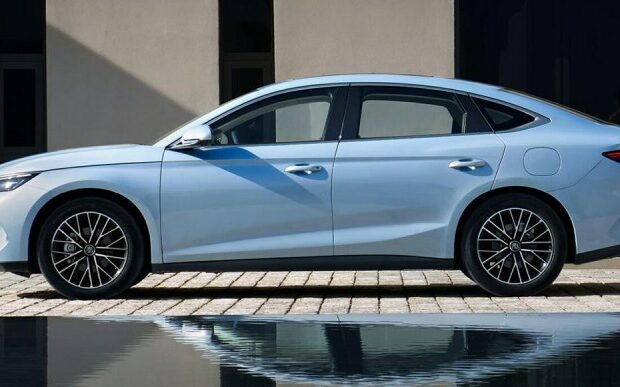At an event in Xian tonight, BYD’s new fifth generation DM system—which the car uses—was unveiled with the BYD Seal 06 DM-i. The Qin L DM-i, the Seal 06’s twin car that rides on the same platform, was also unveiled at the event.
| 80km DM-i Deluxe | 99,800 yuan (13,750 USD) |
| 80km DM-i Prestige | 109,800 yuan (15,150 USD) |
| 120km DM-i Prestige | 119,800 yuan (16,550 USD) |
| 120km DM-i Premium | 129,800 yuan (17,900 USD) |
| 120km DM-i Flagship | 139,800 yuan (19,300 USD) |
The vehicle is visually based on the Seal, which made its debut in 2022, and employs the BYD Ocean series design language, although sharing the same platform as the Qin L. As a result, the Seal 06 features a low grille and a mostly closed front. Only partially hidden are the door handles. A thru taillight cluster is located on the trunk lid at the back. It appears like the BYD emblem on the back lights up at night. The measurements are 1875, 1495, and 4830 mm (l/w/h), with a wheelbase of 2790 mm.
The dashboard and doors, among other interior design aspects, continue the overall Ocean series aesthetic. An 8.8-inch LCD instrument screen and a 15.6-inch rotating centre infotainment screen are included. Six airbags, an electronic stability control (ETC), a mobile phone NFC key, automatic air conditioning, a driver-side window with one touch window control, a tyre pressure monitoring system and at least six speakers are standard on cars.
A panoramic sunroof, the DiPilot L2 driving assistance system, an electric front passenger seat, a dashcam, 18-inch alloys, an eight speaker sound system, and seat heating and ventilation are among the extra equipment found on higher specification vehicles.
The Seal 06 DM-i, along with the Qin L, is the first vehicle to use BYD’s new fifth generation DM technology. This plug-in hybrid system is powered by a 1.5-liter engine that can provide up to 126 Nm of torque and 74 kW of power. Lower-spec models use a 10.08 kWh battery, a 120 kW electric motor with 210 Nm torque, and an 80 km (CLTC) all-electric range. Higher specification models come with a 15.874 kWh battery, which increases the car’s CLTC range to 120 kWh. These also make use of the more potent 160 kW, 260 Nm torque EHS160 motor. In CLTC mode, fuel consumption is 10.7 kWh/100 km, while in NEDC mode, it is 2.9 l/100 km.






